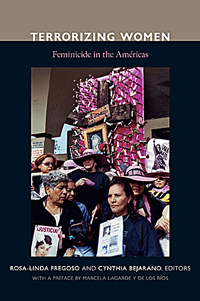Campus News
New book investigates violence against women in Latin America
A new book, coedited by Rosa-Linda Fregoso, professor of Latin American and Latino studies at UC Santa Cruz, investigates the escalation of violence against women in Latin America over the past two decades.


A new book, coedited by Rosa-Linda Fregoso, professor of Latin American and Latino studies at UC Santa Cruz, investigates the escalation of violence against women in Latin America over the past two decades.
In Terrorizing Women, Feminicide in the Américas, (Duke University Press), Fregoso and her coauthors write of more than 600 women and girls who have been murdered and more than 1,000 who have disappeared in the Mexican state of Chihuahua since 1993. During that same period, violence against women has increased elsewhere in Mexico and other countries, including Argentina, Costa Rica, Guatemala, and Peru.
A companion web site, www.stopterrorizingwomen.com, offers more information and resources on the subject.
Fregoso and coeditor Cynthia Bejarano, associate professor of criminal justice at New Mexico State University, compiled personal stories — testimonios — from relatives of victims along with essays from 23 co-authors. The preface is contributed by Marcela Lagarde Y De Los Ríos, a professor at the Universidad Nacional Autóma de México and a member of the Mexican legislature from 2003-2006 who served as president of the Special Commission of Feminicide in Mexico.
Fregoso, a former radio and television journalist from South Texas, has lectured since 1998 internationally and in the United States on the issue of feminicide. She joined the UCSC faculty in 2001 where her writing, research and teaching focus on gender violence, feminicide and human rights, media, artivism and culture.
Terrorizing Women is interdisciplinary, not just in academic terms, but in terms of the authors’ backgrounds, Fregoso said, explaining contributors include feminist and human rights activists, attorneys, and scholars from Latin America and the United States.
The project began about four years ago when Fregoso and Bejarano compared their concerns over patterns of violence seen in border regions — not only at the U.S. and Mexico border, she said. Violence against women in other Latin American border regions is just as prevalent because of”acute structural imbalances in border regions with economic and social insecurity,” Fregoso said.
Violence against women is structural, she said, rooted in social, political, economic, and cultural inequalities. While violence stemming from the illicit drug trade captures most of the headlines, only “10 percent of the violence against women is attributed to drug violence,” she said.
Ninety percent stems from power relationships, legacies of violence and armed conflict, and “systems of impunity” that have been allowed to persist, Fregoso said. While individuals commit most of the violence against women, “one of the risk factor is ideologies, state ideologies that devalue women,” she said.